BR British Rail Crimson & Cream
Crimson and Cream Crimson Cream Blood & Custard Blood Custard Blood and
Custard BR British Rail Crimson & Cream Crimson and Cream Crimson Cream
Blood & Custard Blood Custard Blood and Custard BR British Rail Crimson
& Cream Crimson and Cream Crimson Cream Blood & Custard Blood Custard
Blood and Custard
|
Please support
BloodandCustard! |
British Rail Southern
Region design
MLV
(Motor Luggage Vans Nos.
E68000 & S68001-68010)

MLV
nos.9001 & 9004 at London Bridge (mail traffic) 28th August 1989
© BloodandCustard
Motor Luggage Vans
To
make full use of the facilities provided in the Kent Coast Electrification
scheme, it was decided to provide a number of Motor Luggage Vans (MLV) mainly
to enable the large amounts of luggage to be conveyed on electrically operated
Boat Trains between London and the channel ports at Dover Western Docks and
Folkestone Harbour. These units were to be capable of hauling short van trains
as well as being provided with traction batteries to enable them to work for
short periods in non-electrified sidings.
The
Southern Region’s MLV vehicles were based on an earlier design of the
parcels MLV built at Eastleigh during the autumn of 1955 for use on the South
Tyneside line.
|
Passing the carriage washer at Lovers Walk (Brighton)
is the unique Motor (Parcels) Luggage Van no.E68000 built for the Tyneside
Electrification. Photographed on possibly on 24th or 25th November 1955, no.E68000 is on a test train hauling Crimson
& Cream (CLC) liveried Maunsell coaches. Note the Tyneside headcode, tail
& route indicator lamps, plus the absence of a wiper for the
secondman’s observation light. |
Eastern Region (Tyneside)
Motor Luggage Van (E68000)
E68000
was built at Eastleigh to Diagram No.499 and differed from the later BR(S) MLV
vehicles in having two motor bogies giving four EE507 motors totalling 1000hp.
This unique vehicle was laid out with a driver’s cab at both ends
(entered from behind from the luggage areas) with two large luggage areas, one
each side of a central guard’s compartment. The two luggage areas were
27’ 2” and 21’ 6” long with in intervening
guard’s compartment being 6’ 9” wide. Both luggage areas
had a long-hinged seat along the right-hand side when looking forwards.

There
were four pairs of double doors along each bodyside; those pairs towards the
outer ends (close to the cab) were equipped with one inward and one outward
opening door; both with sidelights and the inwards opening door being that
closest to the cab. The remaining pairs of doors both opened outwards and only
one had a sidelight; this being the left-hand door when viewing the bodyside.

|
Interior of E68000 (Guard’s compt.) |
The
guard’s compartment had an inwards opening door equipped with a
droplight. There were also four large sidelights in the bodyside, the outermost
two being centrally placed between the two pairs of double doors of each
luggage area. The remaining two sidelightss were
located towards the centre of the coach being asymmetrically placed each side
of the guard’s door, that to the left of the door being of frosted glass
to give the guard privacy. All these sidelights were divided roughly ¼
& ¾ by a horizontal bar across them towards the top.

|
Interior of E68000 (Guard’s compt.) |
Driving
cab ends had a central panel with four white lights (placed in a square) with a
red tail light in the centre of then (arranged like a ‘five’ on a
dice). Above this was a large, combined destination and route display, with a
large aperture at the top for destination and a smaller one below for the
route. These displays were displayed on roller blinds and illuminated from
behind.
The
usual whistle was mounted above the driver’s observation light which had
a windscreen wiper; the offside observation light was not so fitted. The vehicle
was finished in plain green (with no lining) and the first style BR crest was
placed below the sidelight to the right of the guard’s door. The two 8’ 9”
wheelbase motor bogies were centred at 46’ 6” centre; both
carried shoegear. E68000 was not equipped with traction batteries.

|
Official photograph of E68000 |
Delivery and Testing on the Southern
E68000
was delivered to Peckham Rye shops week ended 29th October 1955 for
extensive trials and suffered some faults and a fire. However, it was tested on
the BR(S) hauling trains of 6, then 8 coaches from Brighton to London
Bridge and back on 24th and 25th November 1955. It was
then used hauling goods trains from Norwood to Three Bridges and Horsham,
working the 12.45pm Norwood Junction to Horsham on Monday 5th
December 1955, before being sent to South Gosforth, arriving there on 3rd January
1956.

|
Official photograph of E68000 |
Tyneside, Liverpool and back for Scrapping
On
2nd & 3rd March 1956 E68000 worked demonstration
trips from Newcastle to South Shields and went into traffic from 19th
March 1956.
Following
the conversion of the Tyneside electrified lines to diesel multiple unit
operation, E68000 was transferred to Southport for use on the Liverpool to
Southport line, going there from 10th August 1963 and being renumbered
M68000. In service it erroneously appeared with an ‘M’ suffix
(M68000M); this number being carried on the cab front between the former jumper
cable sockets.
M68000M
also carried a full-width yellow warning panel, was equipped with two marker
lights (probably tail lamps) one each side above but slightly offset (outside)
from each buffer. Although it retained a drop buckeye it had lost its
compression bar and also gained two diagonal air-pipes up to the forward
observation lights from where the compression bar was once mounted. The waist
level dual cocks (fitted as SR standard and used on the Tyneside units) were
blanked off with these pipes fitted to take them down to the headstock. Oddly
it is the Train Pipe on the right- hand side and the Main Reservoir on the
left-hand side.
The
Tyneside marker lights had been plated-in and the vehicle endorse ‘FISH
TRAFFIC THIS END’ on one of the cab fronts just below and outside of the
second man’s cab light as well as on the vehicle sides between two pairs
of the double doors. Livery was a darker green to the BR(S) emu green; this
matching the Southport electric units.
It
was taken out of use in 1965; there being a rare, published photograph
(Merseyside Electrics pub. Ian Allan) shewing it in use at for parcels and fish
traffic at Formby station on 8th May 1965; one luggage section being
marked for fish – the other for parcels.
Once
out of use it was stored at Meols Cop (Southport)
until officially withdrawal on 25th March 1967 and scrapping by W.
Willoughby of Ashington, Northumberland during August 1967 in a yard at
Choppington (then adjacent to Portland Park football ground) more renown for
breaking omnibuses.

|
MLV no.S68009 at Grosvenor Shed (Victoria
SE). © late Alan Hawes collection |
Southern Region
Motor Luggage Vans (68001 – 68010)
Two
vehicles, numbered 68001 & 68002 were ordered for ‘Phase 1’
of the Kent Coast scheme, and a further eight, 68003 to 68010
followed with ‘Phase 2’. Lot numbers were 30458 (68001 & 68002)
and 30623 (68003 ‑ 10), these being ordered 22nd
February 1957 (30458) and 29th July 1959 (30623). The first two (68001/2)
were delivered in May 1959 and were ready for the commencement of electric
services on 15th June 1959; the remainder being in traffic by
March 1961.

|
On Thursday 2nd
March 1961 an unidentified Phase ‘2’ MLV leads a Dover
Marine to Victoria headcode ‘74’ Boat Train on the Up Chatham
Slow through Bickley Station. Note the Phase
‘2’ MLV’s dropped buckeye coupler. © Ben Brooksbank (Geograph/CC-by-SA) |
BR(S) MLV Vehicles
All
the BR(S) MLV vehicles were built at Eastleigh on standard 63' 6"
length underframes fabricated at Ashford. These vehicles were 64' 6"
long over bodywork, the length over buffers (extended) being 67' 1".
Gangway connections were not provided for security reasons; the luggage on boat
trains being conveyed under customs seal and the vehicles therefore had the
standard non‑gangwayed cab end design as used
for the BR type 2 HAP and 2 EPB units.
Each
vehicle consisted of a driver’s cab 4' 2½" deep, at the
No.1 end (motor bogie) this entered via a small 6' 7½" wide
guard's compartment with a single inward-opening door on each side. Adjacent to
the guard’s compartment was the large luggage area,
27' 7¾" long and provided with two pairs of outward opening
doors on each side. Towards the No.2 end (trailer bogie) was the smaller
luggage area, 18' 6" long with a single pair of outward opening doors
each side. Devoid of droplights, all these outward-opening double-doors were
significantly wider than those used elsewhere on Mk1 stock. Finally, there was
an entrance vestibule with inwards opening doors giving access to the remaining
driving cab.

|
Detail view of the opposite
ends of departmental MLV vehicles nos.931092 (NSE) 931090 (Jaffa Cake) at Ramsgate
depot yard on Saturday, 24th April 1993. On no.931092 (No.1
end) some of the battery box covers can be seen alongside the Guard’s
compartment (with its external door set further back from the driving cab
bulkhead) This compares to the non-Guard’s compartment (No.2) end of
no.931090. Both cabs are 4’
2½” deep. However, there is an equipment cabinet behind the
secondman’s position which impinges into the Guard’s compartment
resulting in the Guard’s door being set further back from the
partition. In addition, the secondman’s side light (whose seat is
mounted beneath) is smaller than the driver’s side light. Also visible are the
T-section vertical lifeguards of the 8’9” wheelbase Mk3b motor
bogies (here on no.931092) in comparison to the flat-section (bar) vertical
lifeguards mounted on the 8’6” wheelbase Mk3b non-motored bogies
(here on no.931090). Finally, the
larger-than-standard double-doors can be seen (possibly unique to the MLV vehicles?);
the left and door of each pair was fixed (i.e. not fitted with a droplight).
The side lights (including doors) of each luggage area were equipped with
protective wire-mesh grills. The Guard’s periscopes have long been
removed. ©
Colin Price |
The
MLV vehicles had a capacity of 132 cu. yds, being divided as 80 cu.
yds in the large luggage area, 52 cu. yds in the smaller. Through access
from one end of the vehicle to the other was possible as each dividing
partition had a sliding door. Overall vehicle weight was 45 tons unladen
and 7 tons of luggage was permitted.
There
were three large sidelights along the bodysides of the vehicles. From the No. 1
(guard’s compartment) end there weren’t any sidelights between the
guard’s door and first pair of double doors as the bodysides here each had
six hinged covers to allow access to the traction batteries. The first sidelight
was centrally between the next two sets of outward-opening double doors, the
second sidelight was centrally between the next two sets of outward-opening double
doors; the third was between the last set of double doors and the No. 2 end cab
vestibule door, this sidelight being much closer to both sets of doors than the
first two. All of these sidelights had a horizontal dividing bar across them
towards the top dividing them roughly ¼ & ¾.
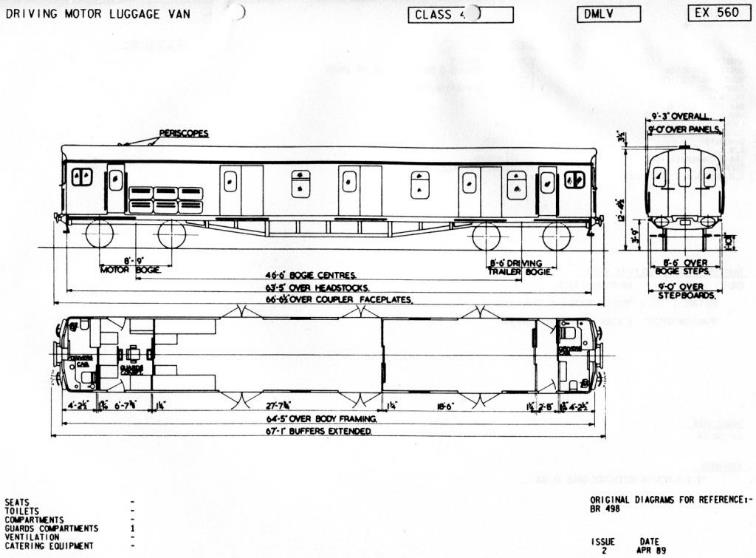

All
vehicles were identical in overall appearance, although the first two (type AF)
had 1957 ‘phase 1’ equipment. The remainder (type AF-1A) had 1957
‘phase 2’ equipment but in a ‘phase 1’ style
body, these being built with conduits and wiring for Westinghouse AWS equipment
(although this was sealed out of use).
Like the Tyneside MLV, the first two BR(S) versions (type AF) were not
fitted with a wiper on the Secondman’s observation light (the type AF-1A
were fitted).
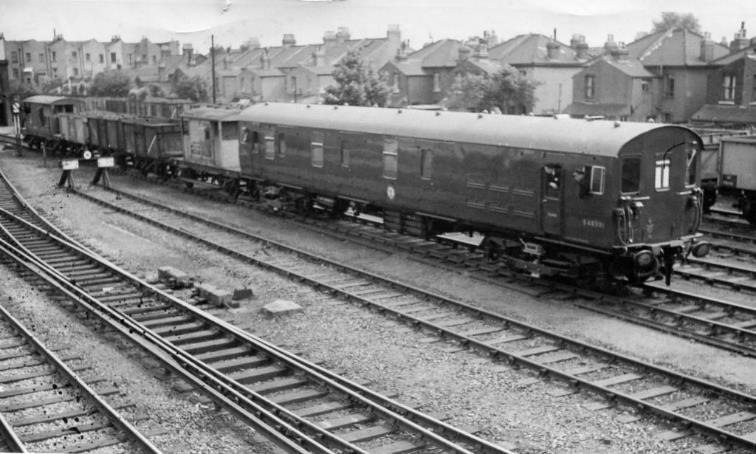
|
Possibly in early-May 1959, MLV no.S68001 off the ‘juice’
propelling out of Norwood’s Down Goods Line alongside the south end of
the station. The houses to the right are in Carmichael Road with the
three-story terrace being Clifford Road. The furthest (bogie) brake van is a Queen Mary with three steel 16T
mineral wagons sandwiched between an ex.SECR (RH
ducket) brake van; the sum load of this train being around 100 tons which was
the maximum rating for a solo MLV. With all train’s staff looking north (driver at controls, guard
at open droplight and somebody looking out of the secondman’s opening
side light) this train could be setting back ready to go out on a test run.
Subsequent to this, MLV no.S68002 undertook its own test trips on 25th
/26th June 1959. The forward and rearward periscopes of the MLV are clearly visible
(later removed). Like the Tyneside MLV, the first two BR(S) versions (type
AF) were not fitted with a wiper on the Secondman’s observation light
(the type AF-1A were fitted). In the foreground note the two side ramps
on the conductor rail for the turnouts. Courtesy of Colin Price |
Battery
Power
To
enable the MLV vehicles to run ‘off the juice’ (mainly in sidings
at Dover and Folkestone) they had banks of batteries to supply power at 200V
for the traction motors, compressors and vacuum exhausters; these being charged
by an auxiliary generator coupled to the motor generator when the unit was on
the third rail.
To
protect the battery supply
from the 750v live-rail supply, the shoegear
was lifted by air-pressure when battery-operation was selected by the driver
(using the battery-on button); essentially a pneumatic equivalent to
‘paddling-up’ to disconnect the MLV from line-voltage. The
battery-off button ended battery operation, lowered the shoegear with the
line-light re-illuminating upon contact with the (energised) live-rail.
The
batteries were located along the bodysides in the larger luggage bay at the
No. 1 end of the vehicle and were accessed by six exterior access flaps. When
built the first two MLV vehicles (nos.68001 & 68002) had different fuse
boxes and battery access hatches from the later eight. In later years further
changes to the access hatches appear to have been made to most (if not all) of
the MLV vehicles.
Motors
& Bogies
The
first two ‘Phase 1’ MLV vehicles (nos.68001 & 68002) had
the electrical code AF, the remainder ‘Phase 2’ being AF‑1A.
All were to Diagram No. 498. Each was mounted on BR Mk 3b motor bogies;
the No. 1 end being the 8' 9" wheelbase motorbogie
being and fitted with two EE507 250hp motors whilst the No. 2 end was an
8' 6" wheelbase Mk3b driving trailer bogie identical to those used
under the driving trailer cabs of the BR type 2 HAP units nos.6106 –
6146.
Both
MLV bogies were equipped with shoegear which was lifted off the conductor rail by
air-pressure when battery-operation was selected by the driver. Besides the
switching from line-voltage to battery voltage, raising the shoegear also
placed it out of ‘harm’s-way’ in those sidings where
conductor rail run-on ramps may not be robustly maintained else debris /unused
con-rail pots etc. could otherwise catch the shoes. However, if a MLV needed to
traverse a route not cleared for shoegear then (like other third-rail EMU
stock) the shoegear had to be temporarily removed.
This
arrangement on the MLV vehicles predated the Electro-Diesel Locomotives (EDL)
whose air-pressure lowered the shoegear; this being in-part a fail-safe for
when Electro-Diesel Locomotives entered possessions (or routes not cleared for
shoegear) where the shoegear needed to be fully-retracted inside of the loading
gauge and not just lifted a few inches clear of the conductor rail. [Should there be insufficient air
pressure to lower the shoes when an EDL was required for service, drivers could
either charge the compressed-air system by starting the diesel engine else use
an emergency foot-pump].
Braking
In
order to further increase the usefulness of the MLV vehicles they were equipped
with vacuum exhausters which enabled them to be used as locomotives hauling
vacuum braked parcels vans (for which a vacuum brake connection was provided at
each end at solebar level). 100-ton loads were allowed to be hauled by an MLV,
though this was reduced to 50 tons up the steeply graded Folkestone
Harbour branch.
It
was possible to use the first two MLV vehicles (nos.68001 & 68002) to
convert the air braking of a train into vacuum by marshalling them between such
vehicles and few runs were
made in the early 1960s with one of these coupled between an EMU and a locomotive-hauled
Bulleid 3-set. The final batch of eight MLV
vehicles did not have this facility.
The
MLV vehicles had the usual Westinghouse automatic air brake supplemented by the
usual EP brake and were fitted with buckeye couplers and standard brake hose
and jumper cables. This enabled them to run in multiple with all 1951-on types
of BR(S) electric units.
Red Blinds,
Yellow Warning Panels and Whistles
The
original large numeral headcode blinds did not include red blanks and units
were required to display a tail-lamp. In 1958 trials had commenced on some
6-car Hastings diesel sets using Double Red Blanks instead of a tail lamp. Once
these were accepted, from May 1960 the roller blinds on the EP
stock were swiftly changed as this was a relative simple task.
The
new blinds included the use of a different (visually more-squat) font and
contained 0, 1, 2, 3, 4, Red blank, White blank, Black blank, 5, 6 7, 8. 9 on
each roller; the Red blanks (etc) being placed mid-roll to reducing the winding
required.
It
is not recorded if the change in typeface was (at least in part) to provide an
immediate indication to staff as to whether the roll contained red blanks or
not. A few EP units retained the early style headcode blinds into 1962.
Her Majesty’s Railway
Inspectorate required the red blanks /tail-lamps to be illuminated for at least
30 minutes after any traction failure and some units such as the few 4 SUB
units equipped with roller blinds (which were never equipped with a battery
backup) ended their working lives still using oil-lit tail-lamps.
The
fitment of yellow warning panels by the Southern Region on multiple unit stock
commenced in earnest late-1963 with MLVs recorded as receiving these from August
1964-on. Around 1963 the whistles started being replaced with two-tone air
horns; some EP units retaining their whistles into 1966. Undertaken in-works,
their fitment often coincided with yellow warning panels.
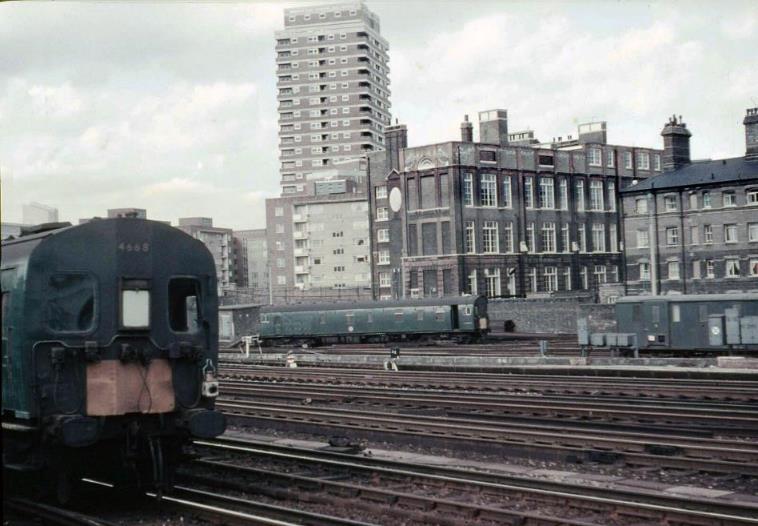
|
In its typical position, an unidentified MLV with (yellow warning
panel) awaits its next duty at Grosvenor Shed (Victoria) as 4 SUB no.4688
rattles past. Of additional interest, an SNCF
Fourgon from the Night Ferry is poking out of the shed © BloodandCustard |
Delivery
All
the MLV vehicles were delivered in all‑over green livery and initially did
not carry unit numbers, just the vehicle number (with an S prefix) in the usual
coaching stock position on the bodysides. The first two were equipped with
whistles but the final batch of eight was delivered with air horns.
Dates
completed were as follows:
|
68001 |
25th April 1959 |
|
68002 |
5th May 1959 |
|
68003 |
23rd December 1960
(in traffic by 14th February
1961). |
|
68004 |
29th December 1960 |
|
68005 |
4th January 1961 |
|
68006 |
16th January 1961 |
|
68007 |
24th February 1961 |
|
68008 |
9th March 1961 |
|
68009 |
14th March 1961 |
|
68010 |
28th March 1961 |
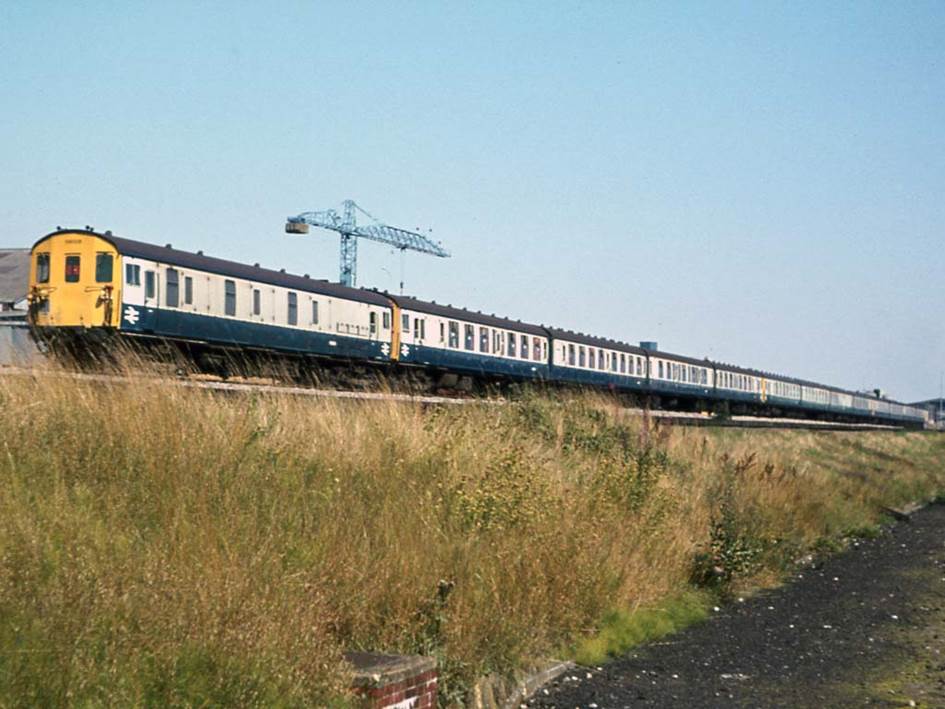
|
Saturday,
19th August 1978 and an unidentified MLV is at the rear of a
CEP-BEP-CEP Down boat train formation passing Chart Leacon Works on the
approach to Ashford. © Tony Watson |
Into Traffic
MLV
number 68001 was delivered to Selhurst by 5th May 1959 before
moving to Peckham Rye on 12th May 1959 for further testing
and inspection at Waterloo on Thursday 4th June. 1959. Number 68002
was subsequently used on some test trips hauling freight stock between Norwood
and Three Bridges yards on 25th/26th June 1959.
From
18th January 1960, one of the MLV vehicles was diagrammed to work an
evening parcels train from Cannon Street to Dartford and back with a
trailing load of up to four vans. From 22nd February 1960 a further
trip was then diagrammed for the other MLV at 7.0pm from Holborn Viaduct to
Wrotham, returning at 8.37pm. From this date the MLV off the Dartford train then
ran empty to Holborn Viaduct where both MLV vehicles were coupled prior to
working the 11.16pm vans to Victoria; this train having a permitted tail load
of 200 tons.
The
Waterloo record card for 4 Cor coaching set 883 contains a note stating the set
was used for trial runs with 68008 but on 16th May 1960?
Following
delivery of the second ‘Phase 2’ batch of MLV vehicles their area
of operations was increased and they were occasionally used for other special
movements; on 16th March 1961 number 68002 hauled Pullman cars
Perseus & Zena and a van from Stewarts Lane to Lancing works, whilst on the
following day no.68001 was seen on a working from Lancing to Stewarts Lane
hauling three loco-hauled corridor coaches.
One
MLV (believed to be no.68009) was used for some static AWS tests based at
Wimbledon S&T depot during 1961.
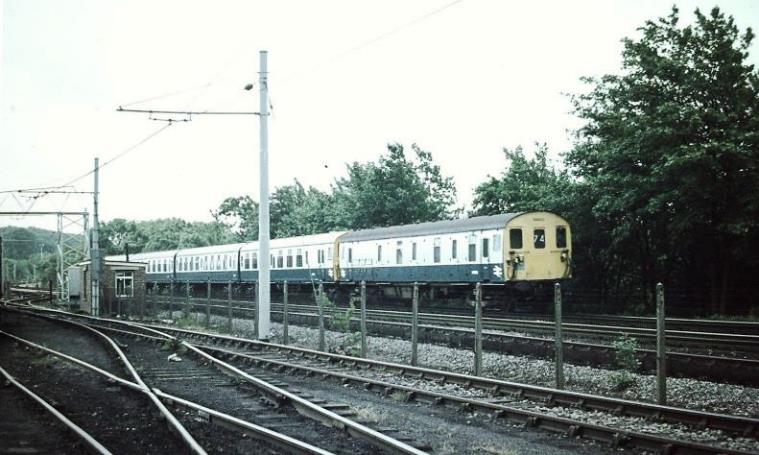
|
Sporting
headcode 74 (Victoria to Dover Priory via Canterbury East), MLV no.68002 on a
positioning move at the front of a 4 CEP passing Snowdown Colliery. Note the
sidings’ overhead wiring for the BR(S) electric locomotives. © BloodandCustard |
Restrictions
Excepting
the ‘C1’ gauge (Southern Route Restriction ‘4’) there
were no restrictions for MLV vehicles running solo. However, they were subject
to a maximum trailing load of 100 tons gross when hauling tail traffic, except
between Folkestone East and Folkestone Harbour when the maximum trailing load
was 50 tons gross (information correct to
6th May 1968).
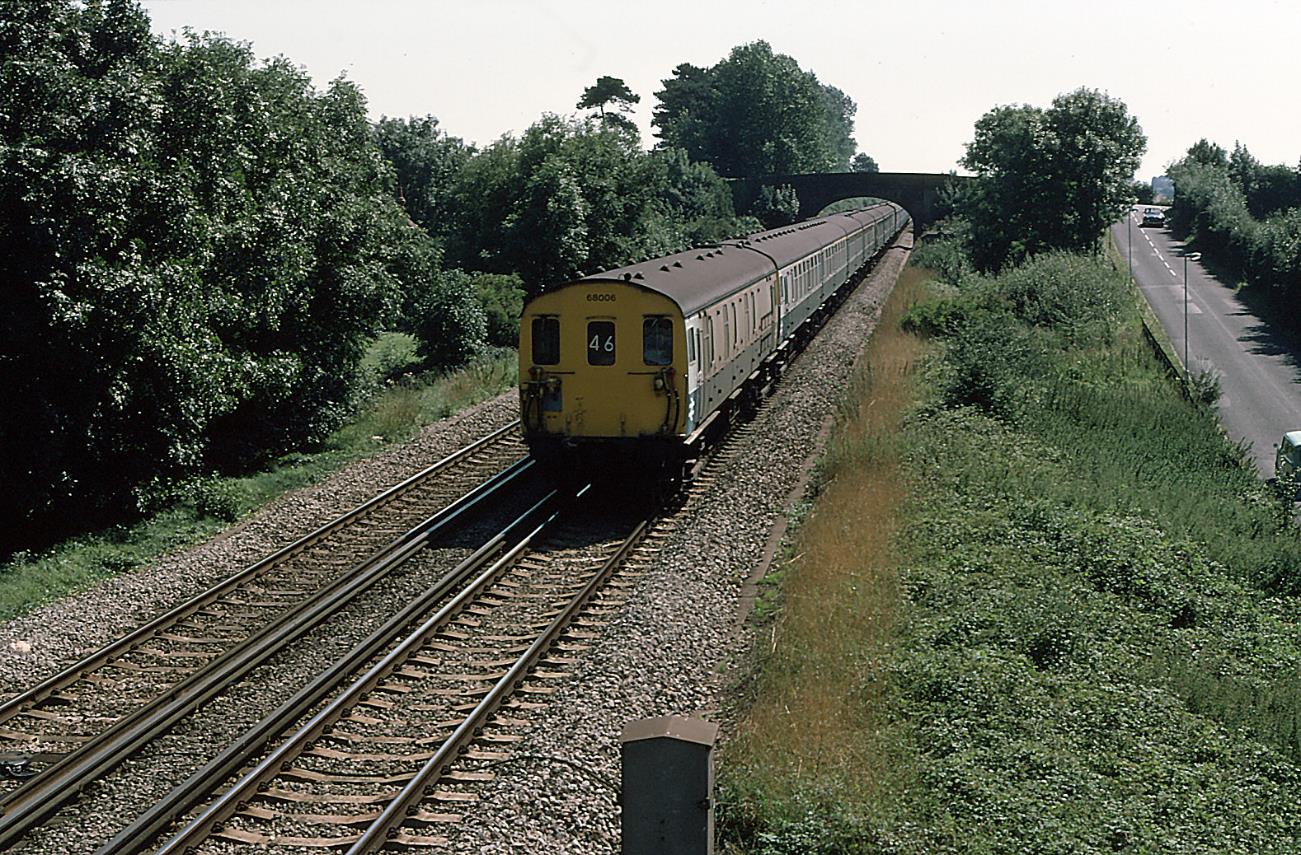
|
An MLV leads a TLV and a mixed-livery 12 CEP
formation through Faversham |
|
An unidentified MLV
leads a TLV and a 12-CEP formation through Faversham on a Dover Marine to Victoria
via Chatham and the Catford Loop boat train on the 21st
April 1968. The MLV has yet to display its’ identity on the cab front
as well as the bodysides. Examination of this colour transparency indicates
that the CEP units are in each of the three liveries they carried, namely
green, blue and blue /grey. To the left of MLV can
be seen an EDL coupled to a Mark 1 BSK; this being from one of the two paper trains from
Victoria to Dover. Both trains terminated at Dover Marine and the
stock was made up into one empty van train that went to Bricklayers Arms
sometime in the morning. This train also conveyed the ‘South Eastern’
BSK. The ‘South Eastern’ train was booked
as a passenger service to Folkestone Central; thereafter as a staff train for
Dover Marine (although few argued if there was a fare paying passenger for
Dover!). The ‘Chatham’ service split at
Faversham with a locomotive plus BSK and vans would form
the Ramsgate portion. Another locomotive and BSK would then attach to the
remaining vans before heading for Dover. At Dover it was shunted into Dover Town
Yard by the station pilot (after having been cleaned and watered) and
attached to the 11.55hrs freight from Dover Town to Faversham. This train
usually only consisted of several Interfrigo ferry
vans of fruit and was air-braked. As the paper train vans were only vacuum-braked
the BSK coaches had to be dual-braked. When this train got to Faversham the BSK would
be detached and berthed in the short siding ready for the following morning. The loco that worked the
train back to Dover arrived several hours before departure, and pre-heated
the coach. With a daily return journey of only 50 miles this
BSK had a pretty leisurely existence until swapped over to another diagram. The locomotives used
for the paper train varied over the years but could be either a Class 33, 71
or 73. With thanks to Tony Francis. |
BR Corporate Liveries
MLV
vehicles gained small yellow warning panels on cab ends from January 1964 and
several also had the vehicle number painted onto the cab end in the usual unit-number
position, though without the ‘S’ prefix.
All
later received blue /grey livery with full yellow ends (and numbers), though following
accident repairs no.68004 was painted all‑over blue with full yellow ends
in March 1967 and carried the vehicle number with an ‘S‘ prefix in
smaller figures than normal on the cab end. No.68004 did not gain blue/grey
until about August 1970; it also had the high-level BR symbol with the
coach number directly below close to the cab end on the bodysides.
Number
68001 was the last MLV to run in green livery up to 2nd March 1970
when it entered Eastleigh Works. Although its blue /grey paint date was 10th
April 1970 it did not emerge from the works until 1st May 1970; this
was not unusual for MLV vehicles.
Pre-preservation
livery painting dates were as follows:
|
Original Number |
Green small warning panel |
Rail Blue |
Blue /Grey |
London South East Sector 1 |
London South East Sector 2 |
|
68001 |
N/K |
No |
10-Apr-70 |
Jun-85 |
No |
|
68002 |
N/K |
No |
2-Oct-68 |
No |
No |
|
68003 |
27-May-65 |
No |
19-Feb-68 |
Mar-86 |
No |
|
68004 |
11-Aug-64 |
30-Mar-67 |
15-Sep-70 |
No |
No |
|
68005 |
N/K |
No |
16-Oct-67 |
Mar-86 |
Wdn#1 |
|
68006 |
11-Dec-66 |
No |
21-Jun-69 |
No |
Renum. |
|
68007 |
26-Nov-66 |
No |
14-Jan-70 |
No |
Renum. |
|
68008 |
15-Mar-65 |
No |
11-Sep-69 |
Jun-86 |
Wdn#1 |
|
68009 |
31-Dec-65 |
No |
10-Mar-70 |
No |
Jul-86 |
|
68010 |
11-Oct-65 |
No |
18-Aug-69 |
No |
4-Dec-86 |
|
New Number |
London South East Sector 2 |
Rail Blue |
Royal Mail Red |
Network South-East |
Final No. (Departmental) |
|
9001 |
No |
No |
Feb-89#1
|
c.Jun-89 |
931091 |
|
9002 |
No |
No |
Part
#5 |
Jun-89
#1 |
931092 |
|
9003 |
No |
Yes#1 |
Wdn |
|
931093 |
|
9004 |
No |
No |
27-Oct-88#1 |
Jul-89 |
931094 |
|
9005 |
Wdn#1 |
|
|
|
931095 |
|
9006 |
27-Jun-88#1 |
Scrapped#3 |
|
|
No |
|
9007 |
c.May-87#2 |
Wdn#4 |
|
|
931097 |
|
9008 |
Wdn#1 |
|
|
|
931098 |
|
9009 |
(Jul-86) |
Wdn#1 |
|
|
931099 |
|
9010 |
(4-Dec-86) |
Wdn#1 |
|
|
931090 |
|
Livery Notes |
|
|
Green small warning panel |
Yellow warning panels may not have
been applied to 68001, 68002 & in particular 68005. If anyone has
information on these please contact us! |
|
Rail blue full yellow ends |
68004 undertook a repaint (Lancing?
1967) following accident damage before the adoption of blue /grey livery. |
|
Blue /Grey |
BR corporate livery |
|
London & South East Sector 1 |
Two-tone brown /orange (‘Jaffa
Cake’) |
|
London & South East Sector 2 |
Two-tone brown /orange but with black
border to orange band |
|
Network South-East livery |
Later livery version (darker blue with
orange electrification band across the cab front above the forward
observation lights (higher than
cantrail level but below the unit numbers). |
|
Rail Blue |
As painted following arrival at
Strawberry Hill depot May 1993 (numbered 9003 at this time) |
|
Royal Mail red livery |
Royal Mail livery discontinued
following the ‘Merstham’ mail train robbery. |
|
Network South-East |
Final main-line service livery of the
MLV (1989-on) |
|
Notes |
|
|
#1 |
Renumbered by this time |
|
#2 |
1987 renumbering may have taken place at the same
time |
|
#3 |
Scrapped March 1994 following a collision with 4
CEP no. 1559 at Ramsgate on 6th December 1991. |
|
#4 |
Scrapped in preservation at Coventry 30th
November 2006. |
|
#5 |
Entered Selhurst Paint Shops 2nd March
1989 and part-way through paining into Royal Mail red. However, no.9002 was
outshopped on 30th May 1989 (also had a GO) in NSE livery
following the robbery near Merstham on 8th March 1989. |
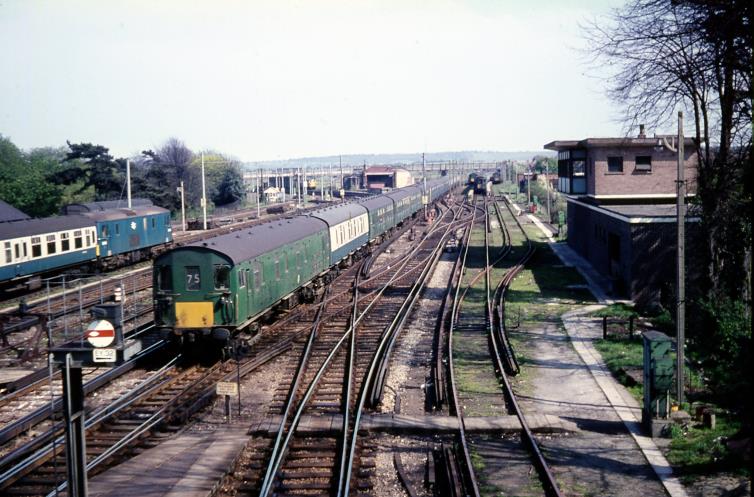
|
From the adjacent
footbridge in August 1979, MLV no.68006 leading a Dover to Victoria service
approaches Willesborough Level Crossing having just
passed under Boys Hall Road in the days when it connected with Crowbridge Road (to the right). This scene is very
different today as a concrete bridge now takes Boys Hall Road across both,
along with High Speed 1 (which runs to the left of the main line). |
BR TOPS
Under
the BR TOPS computer system, the MLV vehicles were initially allocated Class
No. 422/1 in 1972; this later being amended to Class 419 during 1975.
A BR design code was later allocated, these being EX560.0A for nos.68001 & 68002
and EX560.1B for the remainder.
The
MLV vehicles were also shown in the BR TOPS computer system twice (once as
locomotives and once multiple unit stock) making them unique in this respect.
This facilitated their use (in pairs) hauling ‘water trains’
between Dover and Ramsgate, these running about 1984 during a water shortage
and took water from a well on BR property at Dover for use in the carriage
washing plant at Ramsgate depot. Up to two four-wheel vacuum-braked tanks were
hauled on each occasion.
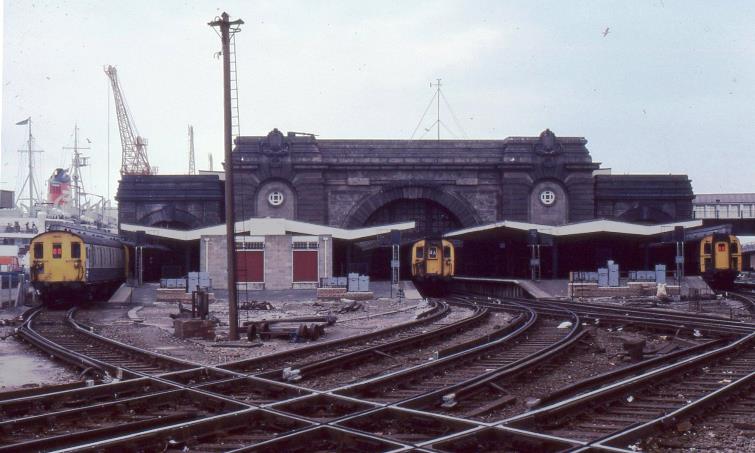
|
With
its buckeye already dropped ready for shunting onto the Quay (at Dover Marine
Station) over an unmanned public foot crossing by
a 08 /09 locomotive, the red /white blinds suggest MLV no.68002 and an
unidentified TLV are being shunted from Grovesnor
car sheds into Victoria thence to on the rear of a boat train. © Dave Smith |
Trailer Luggage Vans (TLV)
(68201 – 68206)
On
occasions the amount of luggage carried on certain Boat Trains exceeded the
capacity of the MLV vehicles requiring the employment of two MLV vehicles.
However, this led to an excessive power to weight ratio and the conductor rail
index of 16 for a 2xMLV + 12-car CEP (or CEP/BEP/CEP)
formation was the maximum that the electrical equipment in the substations
could handle.
In
order to avoid this, six loco‑hauled Mk 1 BG vans were converted during
1968 and classified as Trailer
Luggage Van (TLV). The conversion
included air & EP braking and fitment of high-level jumper /air hose
connections for use between the MLV and an adjacent 4 CEP unit. The TLVs
were numbered as 68201 ‑ 68206.
They
were not fitted with driving cabs and this led to staffing arguments with the
unions as to whether they were a multiple unit or a hauled vehicle for the
purposes of shunting.
The
TLV were unpopular due to the problems of shunting them and all were withdrawn
from these duties in 1975. By this time, the amount of luggage being conveyed
had declined so that one MLV could handle all the traffic satisfactorily.
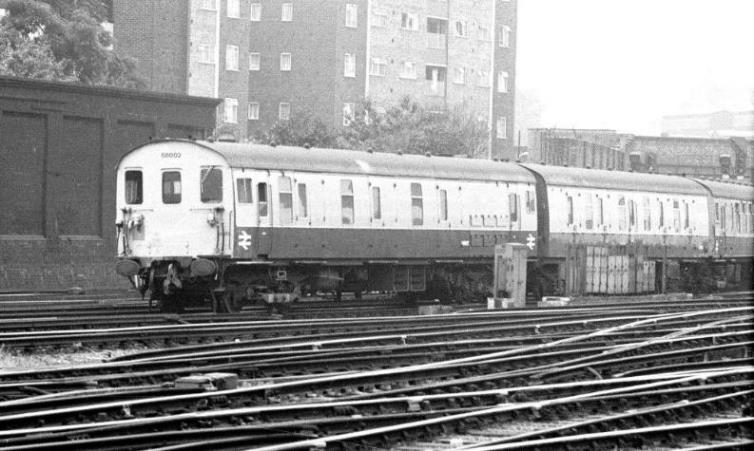
|
MLV
no.68010 leading 2 HAP no.6087 at Waterloo East on Friday, 15th
August 1986 with the 06.43?hrs London Bridge (low level) to Charing Cross
(having previously arrived from Redhill – the 2 HAP providing
additional brake force). This was a Sundays-excepted positioning move where
the three would be attached to the front of the 07.00hrs Charing Cross to
Ramsgate - on this day it was 2 HAP + MLV + 4 CEP (rostered). At Ramsgate the
2 HAP & MLV were detached thence off to the depot. © John Atkinson |
CED Parcels Traffic & Modifications
Further
decline in the amount of registered luggage traffic led to the increasing use
of MLV vehicles on parcels trains on the Central Division (CED); usually
operating singly, though sometimes hauling vans. For instance, during 1972 one MLV
was diagrammed to run empty from Victoria to Bricklayers Arms and then worked the
05V00 Bricklayers Arms to Epsom van train; this involved some use of the
traction batteries in the sidings at Bricklayers Arms.
Two examples of van haulage commenced 2nd May 1977
with the Mondays to Saturday 04.48 Victoria (16) to Redhill (mail) thence to
London Bridge (7) arr 06.06 and the Monday to Friday
21.15 Victoria (11) to Redhill via East Croydon with CCTs attached for Crewe
& Leeds (one each) thence return to Victoria (7) arr.22.58.
However,
a number of instances of overrunning signals and a buffer stop collision at
London Bridge (low level) on Thursday, 18th April 1985 led to
the ‘blacking’ of the MLV vehicles by drivers. The problems
occurred when a defect in the braking system reduced its effectiveness so the MLV
vehicles were banned from running solo whilst a programme of modifications was
carried out at Selhurst. This was to fit them with an additional brake cylinder
whilst separating the braking of each bogie so that in the event of failure,
only 50% of the braking system was affected.
Whilst
this programme was being carried out, certain mail train workings operated with
a 2 HAP ‘runner’ attached to the MLV with 2 HAP units nos.6011
/6087 & 6103 being retained for this purpose beyond their planned
withdrawal dates.
All
the MLV vehicles were eventually modified and were also fitted with a Speed
Sensing device (SSF) to enable then to run under Driver Only Operating (DOO)
conditions. This increased their sphere of operations considerably,
particularly on the Central Division with regular workings at various times to destinations
such as East Grinstead, Seaford, Horsham, Littlehampton and Bognor Regis.
AWS
The
MLV vehicles were also all fitted with AWS equipment at this time (they were
amongst the last units to be equipped) with the AWS equipment being made
operational as follows:
|
68001 |
July
1985 |
68006 |
December
1985 |
|
68002 |
March
1984 |
68007 |
April
1984 |
|
68003 |
November
1984 |
68008 |
July
1986 |
|
68004 |
April
1985 |
68009 |
April
1984 |
|
68005 |
January
1986 |
68010 |
June
1985 |
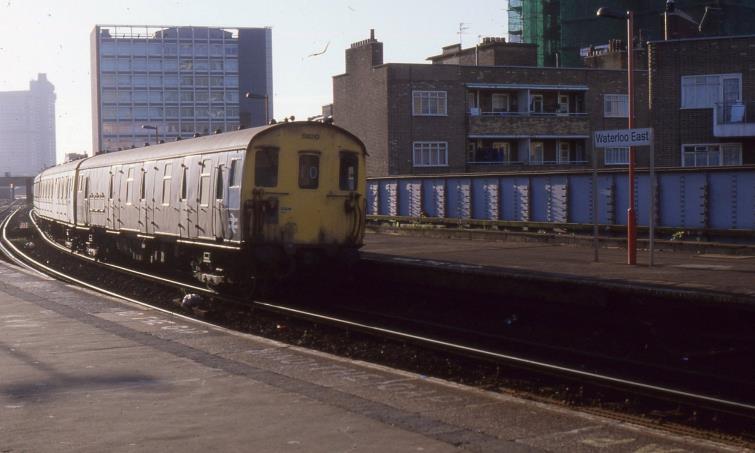
|
Leading a
single ‘Jaffa-cake’ 4 CEP, MLV no.68010 departs from Tonbridge on
Saturday 3rd May 1986 with the 07.00hrs Charing Cross to Ramsgate
via Dover Priory. © John Atkinson |
Incidents
|
Date |
|
|
c.
May 1960 |
Around
May 1960 MLV number 68001 was damaged (location
unknown) and sent to Eastleigh for repairs on 6th June 1960;
it was released on 2nd July 1960. |
|
25th
February 1966 |
Number
68001
was further damaged in buffer stop collision at Victoria on 25th
February 1966. |
|
6th November
1986 |
On
6th November 1986 number 68005 was badly damaged in a buffer stop collision at
Redhill when it struck a bridge parapet. Repairs at Slade Green and
Selhurst followed and the vehicle was released 10th June 1987. |
|
15th
March 1987 |
MLV
no.68001
was further damaged in a buffer stop collision at Ramsgate depot 15th
March 1987 and left hanging partly over the viaduct, but the MLV was soon
repaired. |
|
8th March
1989 |
Merstham;
the ‘Great’ MLV Robbery (see
below) - no.9004 (former 68004). |
|
6th
December 1991 |
As
a consequence of a collision with 4 CEP number 1559 at Ramsgate on 6th
December 1991, MLV number 9006 (former 68006) was withdrawn. After a period of storage at
Ramsgate (thence Eastleigh) it was moved to Gwent Demolition, Margam for
scrapping on 15th March 1994; being cut‑up w/e 26th
March 1994. |

|
Royal Mail liveried MLV no.9004 at Redhill on
17th June 1989. The Royal Mail MLV robbery near Merstham was 8th
March 1989 and this picture was taken just two days before no.9004 went back
into Selhurst Paint Shop on 19th June 1988 no.9004 having been
outshopped in red on 27th October 1988. © John Atkinson |
The ‘Great’ MLV Robbery
Due
to increasing use on mail trains, MLV numbers 9001 to 9005, 9007 & 9009
were allocated to the ‘Parcels Sector’ under the BR
‘sectorisation’ scheme and two were repainted into Royal Mail
red livery, the first no.9004 in October 1988 followed by no.9001 in February
1989. One side of no.9002 had been red painted at Selhurst. However, no.9004
was held up and robbed near Merstham whilst working a Brighton to London Bridge
mail train on 8th March 1989 and a decision to repaint the red
livery units into NSE livery to make them less conspicuous was taken shortly
after; so, they lost this distinctive livery.

|
Led
by no.9006, two ‘Jaffa Cake’ MLV vehicles haul |
Renumbering & Further Livery
Changes
In
early 1986 some MLV vehicles began to be repainted into the new L&SE two-tone
brown livery (known as ‘Jaffa Cake’), nos.68001 /68003 /68005 /68006
/68007 /68008 /68009 & 68010 being so done.
Early
in 1987 the MLV vehicles were allocated unit numbers for the first time as
units nos.9001 ‑ 9010, the first two (9001 /9004) were
renumbered in February 1987, nos.9002 /9003 /9006 /9008 /9009 & 9010
following in March 1987 with nos.9005 & 9007 later after repair. Several (including
nos,9001 /9002 /9003 /9006 9008)
also had their bodyside numbers changed in error, these quickly reverted to
68xxx. These unit numbers were applied low down over the forward observation
lights rather than high up in the centre as previously.

|
Due to the water-shortage,
grubby NSE-liveried MLV vehicles nos. 9001 (leading) & 9004 at Dover
Priory departing for Ramsgate with a single water tanker 60600 on Friday 22nd
February 1991. The tanks
were filled from the water tank at Dover Priory sidings from where it is
recalled that the spring rose In the background a recently
outshopped NSE-liveried 4 VEP can be seen in the sidings along with an
approaching 4 CEP in Priory Tunnel. © John Atkinson |
Network South-East
From
early 1989 (starting with no.9002) the MLV vehicles were repainted into the red
/white /blue NSE livery, though without the upswept arrangement at the cab ends.
From
May 1990 the carriage of mails on BR(S) passenger trains ceased and with very
little remaining work on Boat trains the MLV vehicles had hardly any diagrammed
work, most being used at various depots as shunting horses.
During water shortages in winter
1990-1991 a drought order led to BR using its own spring at Dover (possibly
near site of Hawksbury Street Junction signal box). Air-braked water tanks were
filled at Dover thence hauled by a pair of MLV vehicles to Ramsgate (and
Ashford?) for the carriage washers.
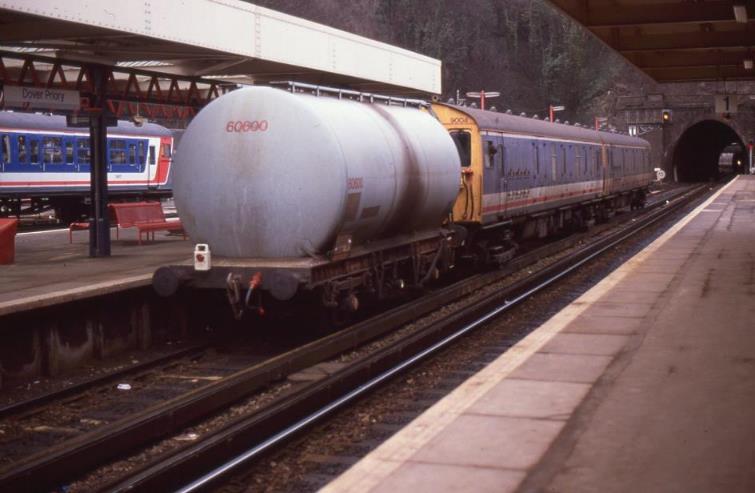
|
MLV
no.931094 (with either no.9003, 9007 or 9009) at Ramsgate 24th
April 1993. ©
Colin Price |
Into Decline
MLV
numbers 9003 /9007 /9008 /9009 & 9010 were out of use during the summer of
1990, stored at Ramsgate and later (Ashford) Chart Leacon. In May 1991 MLV
numbers 9001 /9003 /9005 /9007 /9008 & 9009 were officially withdrawn from
service and stored, the remaining four being withdrawn from 30th September
1991 for further departmental use.
Following
a collision at Ramsgate on 6th December 1991, MLV number 9006 was
withdrawn and after a period of storage at Ramsgate (thence Eastleigh) was
scrapped at Margam w/e 26th March 1994.
All
the remaining MLV vehicles were officially renumbered into the departmental
number series as 931091 ‑ 931099 & 931090 respectively
though not all were physically renumbered as they were stored out of use.
However, nos.931092 (9002) and 931090 (9010) were renumbered at Ramsgate.
At
Slade Green no.931091 (9001) was numbered 091 and no.931094 (9004) & 931095
(9005) were in use at Ramsgate.
MLV
number 9007 was not renumbered 9007, being stored derelict at Ramsgate.
Following collision damage 9006 was stripped at Bournemouth and held at
Eastleigh pending disposal for scrapping. Number 931098 was stored at Slade
Green.

|
MLV
nos
9002 & 9001 working on battery on the Folkestone Harbour pierhead. These were hauling 4 EPB unit no.5001 as part of ‘The
Emerald Water Witch’ railtour down the
branch on a typically overcast Sunday, 29th December 1991. Two MLV vehicles
hauling a passenger train makes this photograph is exceptionally rare! © Colin Price |
In
an attempt to find further work for the MLV vehicles, a trial took place on 15th June
1992 with nos.931091 & 931092 hauling the Ashford Breakdown Crane and Tool
Van on a circular trip from Ashford to Dover, Deal, Minster and back to Ashford
via Canterbury East. Stops were made on Guston bank and a short period of
battery operation tried. Although the conclusion was that they would be
suitable for such use nothing further came of this scheme.
During
May 1993 MLV nos.9003 and 9009 (not renumbered) moved to Strawberry Hill
where they were overhauled for depot ‘horses’ and no.9003 painted
in all‑over rail blue whilst no.9009 retained the now defunct LSE
‘Jaffa Cake’ colours. Whilst at Strawberry Hill number no.9003
was also fitted with Sandite equipment, though this
may never have been used.
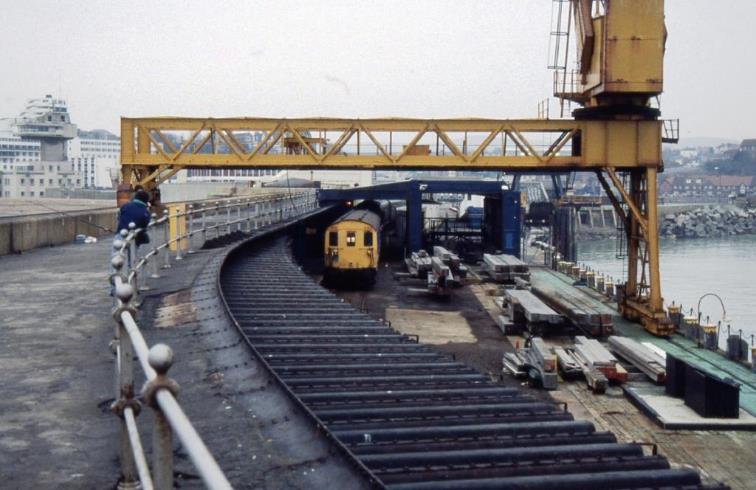
|
Nos.931092 & 931090 sit unused at Ramsgate on Saturday,
24th April 1992. Note the red NSE clock just behind no.931090. © Colin Price |
Privatisation & Porterbrook
Despite
the MLV vehicles now seeing very little use, under the BR privatisation
arrangements all (except scrapped no.68006) were allocated to the ownership of
the Porterbrook train leasing company from 1st April
1994.
Number
931098 was hauled by a 4 VEP unit from Slade Green to Ramsgate (10th
May 1996) and on 23rd May 1996 Ramsgate was cleared of all remaining
MLV vehicles with nos.931092 /931094 /931095 /931097 /931098 & 931010
running to Ashford, though not all were under power. These MLV vehicles
continued (with the addition of no.931091) from Ashford to Strawberry Hill on
24th June 1996 and all nine MLV vehicles were then subject to
inspection for possible use as ‘Sandite’
units on the Merseyrail third rail system.
Late
in June 1996 all nine MLV vehicles were hauled from Strawberry Hill to
Bournemouth for further storage.
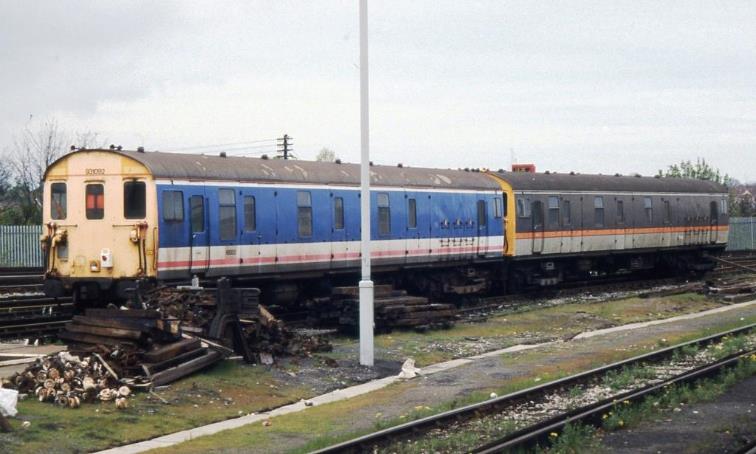
|
MLV no.68010 at Dover
Western Docks on Tuesday, 24th July 1979. Also visible are 4 CEP
(Victoria Boat Train headcode 46) and 4 VEP units. Platform numbering
was, east to west; 3, 4, 5, 6. These numbers referred to the roads, 1
& 2 being on the quayside. Thus all Platforms had access to both
the South Eastern and Chatham mainlines, except for 3 which was for the South
Eastern only. On a few occasions, an
up Boat Train on 3 would have to be shunted over to 4 due to a blockage on
the South Eastern, always fun when a boat-load of inbound passengers had to
be asked to leave the train while it was shunted over. Due to the length and
curvature of the London end of Platform 3, when an MLV had to be attached at
the front to ensure it was leading upon arrival at Victoria, it was necessary
to open both knuckles of the buckeye couplings otherwise with only one
knuckle open, they would not engage. © BloodandCustard |
MLV Operational
Miscellany
(1) Multiple MLVs in one train
The most MLVs in one train were possibly 9019 + 9001 + 9006 + 1608
on 27th December 1989 - Rob Bayliff recalls:
From my
time as Station Supervisor, Dover Western docks (1989-1994), I believe 1A38,
the 15:40hrs Dover Western Docks – London Victoria Channel Train for the
14:15hrs Sealink Calais - Dover Western Docks sailing
on Sunday 24th December 1989 provided the most MLVs worked together
as booked in service. This was by way of working MLVs up to London for
the down Channel Trains on 27th December 1989as the Channel Trains
run on Boxing Day were not booked MLVs.
The
formation was (London End) 9019 + 9001 + 9006 +1608 (Calais End): comfortably
six below the maximum conductor rail current index for all locomotives or units
working under power in a train whether or not in multiple, comfortably six
carriage lengths under the maximum or thirteen for Platform 6 and perhaps most
comfortably a 33% increase in power /weight ratio (when based upon an MLV being
half a 4CEP unit’s-worth with regard to power; three MLVs and a 4CEP
being a unique formation indeed.
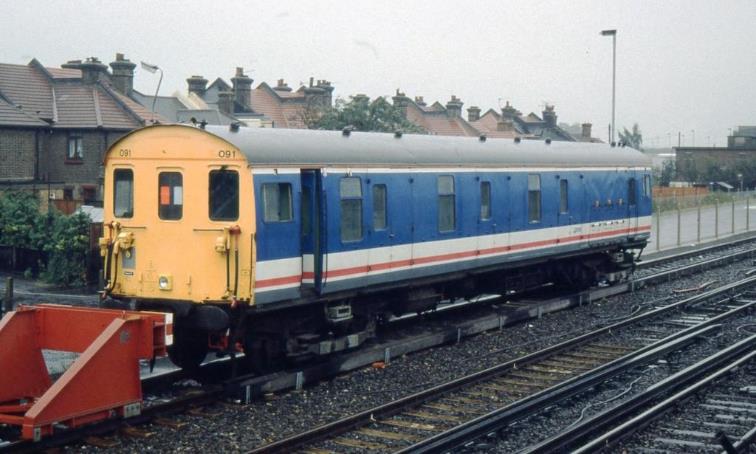
|
26th
September 1982 and MLV no.S68003 at Ashford on the 13.30hrs Charing Cross to
Ramsgate via Dover Priory service; this being the Sunday equivalent of the
weekday position move to return the MLV from its overnight Redhill workings. © Colin Price |
(2) London Bridge to Dover & Margate
(Mail
Train)
The London
Bridge to Dover and Margate weekday mail train was quite long with Margate
section (one or two vans) being detached from the rear upon arrival at Ashford
(usually platform 3); the locomotive taking the front section forward to Dover.
Certainly, between early 1983 (and probably from 1976) until the service
finished in 1986 it was at Ashford where an MLV collected the detached vans
taking them forward (02:33 dep) to Margate. There were also times when the
train only ran to Canterbury or Dover (for example engineering works).
Sample timings
supplied by Clive Standen from his guard’s journals are as follows:
|
Wednesday 19th September 1984 |
||
|
|
Booked Time |
Actual Time |
|
Ashford (68005+1xBG) |
02.33 dep |
02:14 dep |
|
Canterbury West |
02:53 arr |
02:34 arr |
|
|
MLV runs round BG |
|
|
Canterbury West |
03:30 dep |
03:26 dep |
|
Ashford sidings |
03:50 arr |
03:46 arr |
|
Thursday 20th September 1984 |
||
|
|
Booked Time |
Actual Time |
|
Ashford (68003+1xBG) |
03:54 dep |
03:40 dep |
|
Folkestone East |
|
04:14 pass |
|
Canterbury West |
03:30 dep |
03:26 dep |
|
Dover Priory sidings |
04:40 arr |
04:05 arr |
|
Saturday 22nd September 1984 |
||
|
|
Booked Time |
Actual Time |
|
Ashford (68009+1xBG) |
02.33 dep |
02:20 dep |
|
Canterbury West |
02:53 arr |
02:39 arr |
|
Canterbury West |
03:08 dep |
02:47 dep |
|
Ramsgate |
03:27 pass |
03:05 pass |
|
Margate |
03:36 arr |
03:16 arr |
|
|
BG placed into the parcels dock |
|
|
Margate (68009 ecs) |
04:00 dep |
03:37 dep |
|
Ramsgate sidings |
04:08 arr |
03:37 arr |
|
The turn continued with the 05.47
Ramsgate to Charing Cross via Dover as far as Ashford where the night turn
finished. |
||
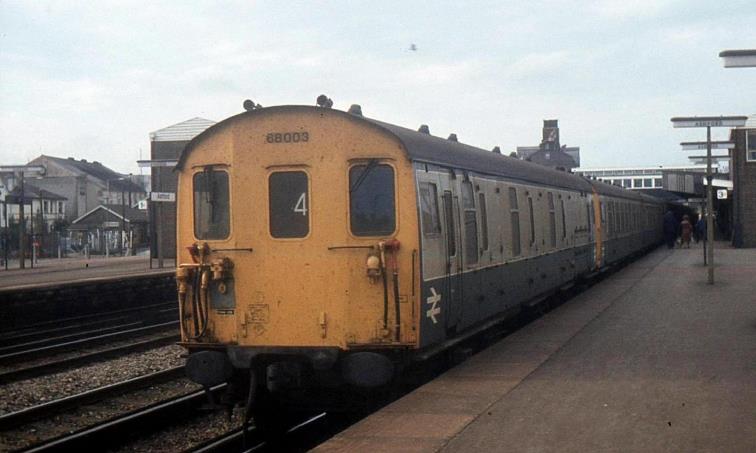
|
MLV
no.9010 hauling a bogie van through Tonbridge 17th June 1989 |
(3) Redhill to Tonbridge
An MLV was diagrammed for overnight mail trains between London
Bridge and Ashford. On occasions these trains were diverted via Redhill (instead
of Sevenoaks) because of engineering possessions with locomotive assistance
being booked between the Redhill and Tonbridge - then a non-electrified section
of railway.
Over there years there have been a number of unsubstantiated
claims seeking to suggest there were occasions when the MLV had run between
Redhill and Tonbridge using only its traction batteries following a lack of
available locomotive from Redhill; usually a class 33 was rostered to loco-haul
the train across from Redhill to Tonbridge.
The railway line from Redhill to Tonbridge is essentially on a
falling gradient much of which is steeper than 1 in 300. However, there are a
number of sections that are not - starting with the slow-start climb out of
Redhill. There are more climbs just after Nutfield
station and on the approach to Godstone station, as well as approximately the
two-miles of level on both the approaches to (and through) Bletchingley and
Penshurst Tunnels.
Most nights between Redhill and Tonbridge only Edenbridge signal
box would have been manned (if at all) and for any failed train the walk to the
nearest signal-post telephone could be lengthy (following placement of
protection behind a failed train).
The ‘connivance’ of Tonbridge signal box would have
needed to provide a clear run into Tonbridge as well. Furthermore, the
operating department would not want to risk needing to recover a stranded train
let alone a mail train; train crew would have a lot of explaining to do as
well!
During the 1980s many of the MLV vehicles struggled to undertake
more than a few shunting moves (if any) before the 200v batteries flattened, so
even a solo MLV working across nearly twenty-miles between Redhill and
Tonbridge would appear highly improbable.
That these
diverted workings left London Bridge on the ‘juice (being met by a
locomotive at Redhill) may have given the impression of batteries being used to
those watching its London departure!
However, if any reader can provide robust confirmation to the
contrary, BloodandCustard would be most interested.
Thanks go Clive Standen
and C. Watts.

|
With
the leading ‘931’ painted out, a smartly-presented no.091 rests
between its duties as the depot shunting horse at Slade Green on Saturday, 26th
September 1992. © Colin Price |
(4) Smithfield Sidings
There is an
unconfirmed but credible report that an MLV was taken into Smithfield Sidings
instead of reversal at Blackfriars (exact
date unknown).

|
No.931090
at Ramsgate depot yard Saturday 24th April 1993. ©
Colin Price |
Sale and Disposal
Around
June 1998 MLV no.68001 was sold to the EPB Preservation Group and later moved
to the East Kent Railway at Shepherd’s Well where it operates with 2 EPB no.5759.
MLV
number 931092 was restored to use (circa September 1998) for use as a depot
shunter at Bournemouth.
Six
further MLV vehicles were sold for preservation about March 2000 with all
moving by road from Bournemouth to their new homes, two of which moved on 28th
March 2000.
MLV
nos.68003 & 68004 went to the Mid Norfolk Railway at Wymondham arriving 17th
March 2000 and 15th March 2000 respectively, nos.68005 & 68008
to the Suburban Electric Railway Association at Coventry and 68009 & 68010
to the Colne Valley Railway at Castle Hedingham. No.68007 was later sold to the
Bullied Electric Preservation, joining nos.68005 & 68008 at Coventry.
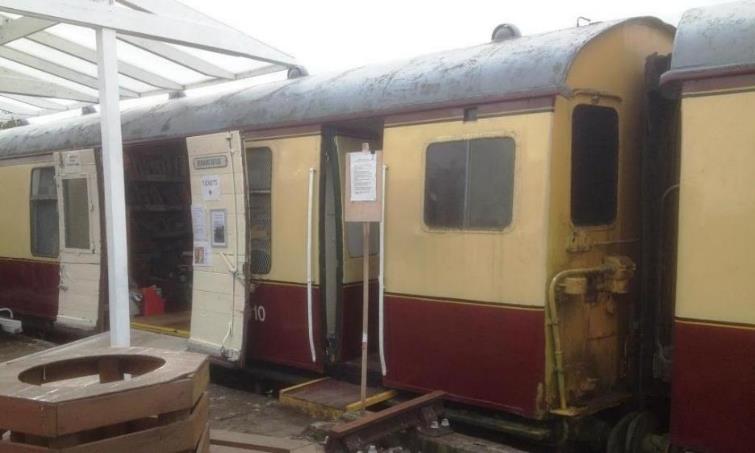
|
In
Blood and Custard livery, preserved MLV no.68010 at |
MLV Preservation Notes
The MLV preservation notes are as follows (correct to 2012).
|
Type AF |
|
|
68001 /9001 /931091 |
East Kent Railway,
Shepherd’s Well (Green livery) |
|
68002 /9002 /931092 |
East Kent Railway,
Shepherd’s Well (NSE livery) |
|
Type AF‑1A |
|
|
68003 /9003 |
Eden Valley Railway, Warcop
(Green livery) |
|
68004 /9004 /931094 |
Mid Norfolk Railway, Dereham
(Green livery) |
|
68005 /9005 /931095 |
Eden Valley Railway, Warcop (Green/L&SE
livery) |
|
68006 /9006 |
SCRAPPED, Gwent Demolition,
Margam March 1994 |
|
68007/9007 |
SCRAPPED, Coventry Railway
Centre November 2006 |
|
68008 /9008 /931098 |
East Kent Railway,
Shepherd’s Well (NSE livery) |
|
68009 /9009 |
East Kent Railway,
Shepherd’s Well (L&SE livery) |
|
68010 /9010 /931090 |
Wensleydale Railway, Leeming
Bar (Green livery) |
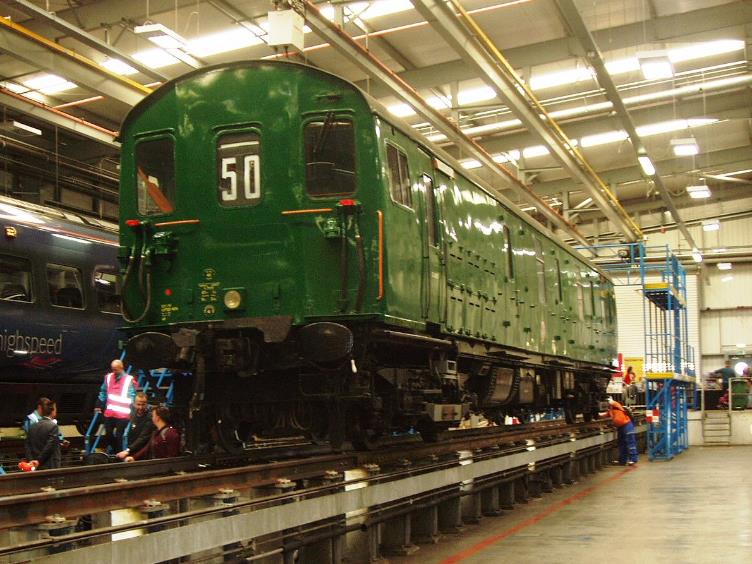
|
Returned to original
green livery with whistles and original style roller-blinds, no.S68001 ‘returned
home’ to Ramsgate depot for the Open Day on 8th June 2019. Note the original
orange handrails and unofficial ‘handbrake-on’ indication of a
shoe paddle having been visibly placed in the secondman’s observation
light. After the Open Day had
finished, S68001 was shunted under its own power in the yard ready to be
hauled back to Southall (with S68002) behind Crompton 33025. The
MLV has been subtly updated to meet current safety & NRIL specifications
(for example the addition of a high intensity headlamp). ©
John Atkinson |
|
Unit |
Preservation notes correct to 2012 |
|
68001 |
Sold
about June 1998 to the EPB preservation group and later moved by road to the
East Kent Railway based at Shepherd’s Well. It was progressively
restored to green livery and used occasionally on battery power to haul 2 EPB
unit number 5759 on passenger trains. |
|
68002 |
Still
at Bournemouth Depot 1th January 2004 and used occasionally as a ‘depot
shunter’. Moved by road to East Kent Railway at
Shepherd’s Well on 3rd /4th February 2004. |
|
68003 |
Initial
sale to a Bulleid Electric Preservation Society (BEPS) shareholder and moved
to the Mid‑Norfolk Railway at Dereham and used as a store shed for use
with restoration work on 4 EPB unit 5176. MLV did not carry its
departmental number on sale. 68003 later resold to a private individual and
moved to the Eden Valley Railway at Warcop where it was restored to working
order and able to move under battery power. Repainted green during 2003. |
|
68004 |
Sold
to a group of Class 50 Locomotive Association members and moved to the Mid‑Norfolk
Railway at Dereham. Currently in use as a PWay
store by the railway. One side in L&SE livery, the other side painted
into green (maybe all-green by now). |
|
68005 |
Purchased
by a BEPS shareholder and moved to the Coventry Railway Centre at Coventry
Airport. MLV had been quite heavily stripped and was sold again in 2001 to
the owner of 68003. It was moved to join 68003 at the Eden Valley Railway,
Warcop where restoration is under way. One side green whilst the other
remains in L&SE livery (maybe all-green by now). Useable on
battery power. |
|
68006 |
Scrapped in 1994. |
|
68007 |
Scrapped
in 2006, S68007 was purchased by a BEPS shareholder and moved to the Coventry
Railway Centre at Coventry Airport for spares. Remained there as a store and
later sold to EPB Preservation Group and scrapped at Coventry 30th
November 2006 with the remains removed during November 2006. |
|
68008 |
Purchased
by a SERA shareholder and moved to the Coventry Railway Centre at Coventry
Airport. Carried unit number ‘098’ when sold. Sold to the East
Kent Railway in May 2005 but not moved to Shepherd’s Well until 7th
September 2007. |
|
68009 |
Purchased
by Colne Valley Diesels and moved to the
Colne Valley Railway at Castle Hedingham for use as a store.
When sold it was not fitted with a headlight. Moved to East Kent Railway at
Shepherd’s Well in early 2009. |
|
68010 |
Purchased
by Colne Valley Diesels and moved to the
Colne Valley Railway at Castle Hedingham for use as a store.
This coach was headlight fitted on sale. It was later moved to the
Wensleydale Railway at Leeming Bar (ownership details unknown). In
2012 being restored, painted green with full yellow ends. However, by 2018 it
was in CLC livery. |

|
Overhauled
and repainted in NSE livery no.9002 on display at Ramsgate depot’s Open
Day on Saturday, 8th June 2019. Note the prominent vacuum hose connection
and later-style roller blind (these included two red blanks in lieu of a tail
lamp). ©
John Atkinson |
|
Thanks go to research author John Atkinson,
webpage author, editorial and additional information from C.Watts,
contributions from Tony Francis, Rob Bayliff & Clive Standena
along with the many photographers
listed below their images. |
MLV in
Model Form
Until
2012 the BR(S) MLV was only available in kit form; the most recent version
being from DC
kits.
Silver-Fox Models marketed a ready-to-run MLV although this is now understood to
be long out of production.
Replica Railways had announced a ready-to run version and displayed full body-mouldings
and parts (which
are available) before producing a motorised
chassis which is currently sold in its
own right for use under many multiple-unit types along with items such as jumper
cables etc. It was understood that the
ready-to-run MLV was awaiting completion when Bachmann announced it was producing its own MLV.
Complementing
its 4-Cep units, Bachmann released its MLV during July 2012 (initially in three versions catalogue
nos.31-265, 266 & 267) before further versions were produced:
|
Type AF (Phase 1) |
||
|
68001 |
BR(S) all-over Green
with whistles |
(Catalogue number 31-265) |
|
68002 |
BR(S) all-over Green
with whistles |
(Catalogue number 31-265A) |
|
Type AF-1A (Phase 2) |
||
|
68004 |
BR corporate all-over
Blue with full yellow ends |
(Catalogue number 31-267Z) |
|
9004 |
Royal Mail Livery |
(Catalogue number 31-265Z) |
|
9004 |
Network South-East livery |
(Catalogue number 31-268) |
|
68006 |
BR(S) Green with yellow
warning panel & two-tone horns |
(Catalogue number 31-266) |
|
68008 |
London & South East Sector 1 ‘Jaffa
Cake’ Livery |
(Catalogue number 31-269) |
|
68008 |
BR corporate Blue /Grey |
(Catalogue number 31-267A) |
|
68009 |
BR corporate Blue /Grey |
(Catalogue number 31-267) |
A comprehensive review of
these models has been taken by the Southern Electric Group.
Unfortunately, some of
the green versions appear to suffer from visible white glue around the sidelight
apertures; a quality-control problem not often found on blue /grey models where
the sidelight glazing surrounds are painted black.
ALL TEXT AND PHOTOGRAPHS
ARE COPYRIGHT
Blood and Custard
Blood & Custard Crimson & Cream Crimson and Cream Plum and Spilt Milk
Blood and Custard Blood & Custard Crimson & Cream Crimson and Cream
Plum and Spilt Milk Blood and Custard Blood & Custard Crimson & Cream
Crimson and Cream Plum and Spilt Milk Blood and Custard Blood & Custard
Crimson & Cream Crimson and Cream Plum and Spilt Milk Blood and Custard
Blood & Custard Crimson & Cream Crimson and Cream Plum and Spilt Milk
Blood and Custard Blood & Custard Crimson & Cream Crimson and Cream
Plum and Spilt Milk Blood and Custard Blood & Custard Crimson & Cream
Crimson and Cream Plum and Spilt Milk Blood and Custard Blood & Custard
Crimson & Cream Crimson and Cream Plum and Spilt Milk Blood and Custard
Blood & Custard Crimson & Cream Crimson and Cream Plum and Spilt Milk
Blood and Custard Blood & Custard Crimson & Cream Crimson and Cream
Plum and Spilt Milk Blood and Custard Blood & Custard Crimson & Cream
Crimson and Cream Plum and Spilt Milk Blood and Custard Blood & Custard
Crimson & Cream Crimson and Cream Plum and Spilt Milk Blood and Custard
Blood & Custard Crimson & Cream Crimson and Cream Plum and Spilt Milk
Blood and Custard Blood & Custard Crimson & Cream Crimson and Cream
Plum and Spilt Milk Blood and Custard Blood & Custard Crimson & Cream
Crimson and Cream Plum and Spilt Milk Blood and Custard Blood & Custard
Crimson & Cream Crimson and Cream Plum and Spilt Milk Blood and Custard
Blood & Custard Crimson & Cream Crimson and Cream Plum and Spilt Milk
Blood and Custard Blood & Custard Crimson & Cream Crimson and Cream
Plum and Spilt Milk Blood and Custard Blood & Custard Crimson & Cream
Crimson and Cream Plum and Spilt Milk Blood and Custard Blood & Custard
Crimson & Cream Crimson and Cream Plum and Spilt Milk Blood and Custard
Blood & Custard Crimson & Cream Crimson and Cream Plum and Spilt Milk
Blood and Custard Blood & Custard Crimson & Cream Crimson and Cream
Plum and Spilt Milk Blood and Custard Blood & Custard Crimson & Cream
Crimson and Cream Plum and Spilt Milk Blood and Custard Blood & Custard
Crimson & Cream Crimson and Cream Plum and Spilt Milk Blood and Custard
Blood & Custard Crimson & Cream Crimson and Cream Plum and Spilt Milk
Blood and Custard Blood & Custard Crimson & Cream Crimson and Cream
Plum and Spilt Milk Blood and Custard Blood & Custard Crimson & Cream
Crimson and Cream Plum and Spilt Milk Blood and Custard Blood & Custard
Crimson & Cream Crimson and Cream Plum and Spilt Milk Blood and Custard
Blood & Custard Crimson & Cream Crimson and Cream Plum and Spilt Milk
Blood and Custard Blood & Custard Crimson & Cream Crimson and Cream
Plum and Spilt Milk Blood and Custard Blood & Custard Crimson & Cream
Crimson and Cream Plum and Spilt Milk Blood and Custard Blood & Custard
Crimson & Cream Crimson and Cream Plum and Spilt Milk Blood and Custard
Blood & Custard Crimson & Cream Crimson and Cream Plum and Spilt Milk
Blood and Custard Blood & Custard Crimson & Cream Crimson and Cream
Plum and Spilt Milk Blood and Custard Blood & Custard Crimson & Cream
Crimson and Cream Plum and Spilt Milk Blood and Custard Blood & Custard
Crimson & Cream Crimson and Cream Plum and Spilt Milk Blood and Custard
Blood & Custard Crimson & Cream Crimson and Cream Plum and Spilt Milk
Blood and Custard Blood & Custard Crimson & Cream Crimson and Cream
Plum and Spilt Milk Blood and Custard Blood & Custard Crimson & Cream
Crimson and Cream Plum and Spilt Milk Blood and Custard Blood & Custard
Crimson & Cream Crimson and Cream Plum and Spilt Milk Blood and Custard Blood
& Custard Crimson & Cream Crimson and Cream Plum and Spilt Milk Blood
and Custard Blood & Custard Crimson & Cream Crimson and Cream Plum and
Spilt Milk Blood and Custard Blood & Custard Crimson & Cream Crimson
and Cream Plum and Spilt Milk Blood and Custard Blood & Custard Crimson
& Cream Crimson and Cream Plum and Spilt Milk Blood and Custard Blood &
Custard Crimson & Cream Crimson and Cream Plum and Spilt Milk Blood and
Custard Blood & Custard Crimson & Cream Crimson and Cream Plum and
Spilt Milk Blood and Custard Blood & Custard Crimson & Cream Crimson
and Cream Plum and Spilt Milk Blood and Custard Blood & Custard Crimson
& Cream Crimson and Cream Plum and Spilt Milk Blood and Custard Blood &
Custard Crimson & Cream Crimson and Cream Plum and Spilt Milk Blood and
Custard Blood & Custard Crimson & Cream Crimson and Cream Plum and
Spilt Milk Blood and Custard Blood & Custard Crimson & Cream Crimson
and Cream Plum and Spilt Milk Blood and Custard Blood & Custard Crimson
& Cream Crimson and Cream Plum and Spilt Milk Blood and Custard Blood &
Custard Crimson & Cream Crimson and Cream Plum and Spilt Milk Blood and
Custard Blood & Custard Crimson & Cream Crimson and Cream Plum and
Spilt Milk Blood and Custard Blood & Custard Crimson & Cream Crimson
and Cream Plum and Spilt Milk Blood and Custard Blood & Custard Crimson
& Cream Crimson and Cream Plum and Spilt Milk Blood and Custard Blood &
Custard Crimson & Cream Crimson and Cream Plum and Spilt Milk Blood and
Custard Blood & Custard Crimson & Cream Crimson and Cream Plum and
Spilt Milk Blood and Custard Blood & Custard Crimson & Cream Crimson
and Cream Plum and Spilt Milk Blood and Custard Blood & Custard Crimson
& Cream Crimson and Cream Plum and Spilt Milk Blood and Custard Blood &
Custard Crimson & Cream Crimson and Cream Plum and Spilt Milk Blood and
Custard Blood & Custard Crimson & Cream Crimson and Cream Plum and
Spilt Milk Blood and Custard Blood & Custard Crimson & Cream Crimson
and Cream Plum and Spilt Milk Blood and Custard Blood & Custard Crimson
& Cream Crimson and Cream Plum and Spilt Milk Blood and Custard Blood &
Custard Crimson & Cream Crimson and Cream Plum and Spilt Milk Blood and
Custard Blood & Custard Crimson & Cream Crimson and Cream Plum and
Spilt Milk Blood and Custard Blood & Custard Crimson & Cream Crimson
and Cream Plum and Spilt Milk Blood and Custard Blood & Custard Crimson
& Cream Crimson and Cream Plum and Spilt Milk Blood and Custard Blood &
Custard Crimson & Cream Crimson and Cream Plum and Spilt Milk Blood and
Custard Blood & Custard Crimson & Cream Crimson and Cream Plum and
Spilt Milk Blood and Custard Blood & Custard Crimson & Cream Crimson
and Cream Plum and Spilt Milk Blood and Custard Blood & Custard Crimson
& Cream Crimson and Cream Plum and Spilt Milk Blood and Custard Blood &
Custard Crimson & Cream Crimson and Cream Plum and Spilt Milk Blood and
Custard Blood & Custard Crimson & Cream Crimson and Cream Plum and
Spilt Milk Blood and Custard Blood & Custard Crimson & Cream Crimson
and Cream Plum and Spilt Milk Blood and Custard Blood & Custard Crimson
& Cream Crimson and Cream Plum and Spilt Milk Blood and Custard Blood &
Custard Crimson & Cream Crimson and Cream Plum and Spilt Milk Blood and
Custard Blood & Custard Crimson & Cream Crimson and Cream Plum and
Spilt Milk Blood and Custard Blood & Custard Crimson & Cream Crimson
and Cream Plum and Spilt Milk Blood and Custard Blood & Custard Crimson
& Cream Crimson and Cream Plum and Spilt Milk Blood and Custard Blood &
Custard Crimson & Cream Crimson and Cream Plum and Spilt Milk Blood and
Custard Blood & Custard Crimson & Cream Crimson and Cream Plum and
Spilt Milk Blood and Custard Blood & Custard Crimson & Cream Crimson
and Cream Plum and Spilt Milk Blood and Custard Blood & Custard Crimson
& Cream Crimson and Cream Plum and Spilt Milk Blood and Custard Blood &
Custard Crimson & Cream Crimson and Cream Plum and Spilt Milk Blood and
Custard Blood & Custard Crimson & Cream Crimson and Cream Plum and
Spilt Milk Blood and Custard Blood & Custard Crimson & Cream Crimson
and Cream Plum and Spilt Milk Blood and Custard Blood & Custard Crimson
& Cream Crimson and Cream Plum and Spilt Milk Blood and Custard Blood &
Custard Crimson & Cream Crimson and Cream Plum and Spilt Milk Blood and
Custard Blood & Custard Crimson & Cream Crimson and Cream Plum and Spilt
Milk Blood and Custard Blood & Custard Crimson & Cream Crimson and
Cream Plum and Spilt Milk Blood and Custard Blood & Custard Crimson &
Cream Crimson and Cream Plum and Spilt Milk Blood and Custard Blood &
Custard Crimson & Cream Crimson and Cream Plum and Spilt Milk Blood and
Custard Blood & Custard Crimson & Cream Crimson and Cream Plum and
Spilt Milk Blood and Custard Blood & Custard Crimson & Cream Crimson
and Cream Plum and Spilt Milk Blood and Custard Blood & Custard Crimson
& Cream Crimson and Cream Plum and Spilt Milk Blood and Custard Blood &
Custard Crimson & Cream Crimson and Cream Plum and Spilt Milk Blood and
Custard Blood & Custard Crimson & Cream Crimson and Cream Plum and
Spilt Milk Blood and Custard Blood & Custard Crimson & Cream Crimson
and Cream Plum and Spilt Milk Blood and Custard Blood & Custard Crimson
& Cream Crimson and Cream Plum and Spilt Milk Blood and Custard Blood &
Custard Crimson & Cream Crimson and Cream Plum and Spilt Milk Blood and
Custard Blood & Custard Crimson & Cream Crimson and Cream Plum and
Spilt Milk Blood and Custard Blood & Custard Crimson & Cream Crimson
and Cream Plum and Spilt Milk Blood and Custard Blood & Custard Crimson
& Cream Crimson and Cream Plum and Spilt Milk Blood and Custard Blood &
Custard Crimson & Cream Crimson and Cream Plum and Spilt Milk Blood and
Custard Blood & Custard Crimson & Cream Crimson and Cream Plum and
Spilt Milk Blood and Custard Blood & Custard Crimson & Cream Crimson
and Cream Plum and Spilt Milk Blood and Custard Blood & Custard Crimson
& Cream Crimson and Cream Plum and Spilt Milk Blood and Custard Blood &
Custard Crimson & Cream Crimson and Cream Plum and Spilt Milk Blood and
Custard Blood & Custard Crimson & Cream Crimson and Cream Plum and
Spilt Milk Blood and Custard Blood & Custard Crimson & Cream Crimson
and Cream Plum and Spilt Milk Blood and Custard Blood & Custard Crimson
& Cream Crimson and Cream Plum and Spilt Milk Blood and Custard Blood &
Custard Crimson & Cream Crimson and Cream Plum and Spilt Milk Blood and
Custard Blood & Custard Crimson & Cream Crimson and Cream Plum and
Spilt Milk Blood and Custard Blood & Custard Crimson & Cream Crimson
and Cream Plum and Spilt Milk Blood and Custard Blood & Custard Crimson
& Cream Crimson and Cream Plum and Spilt Milk Blood and Custard Blood &
Custard Crimson & Cream Crimson and Cream Plum and Spilt Milk Blood and
Custard Blood & Custard Crimson & Cream Crimson and Cream Plum and
Spilt Milk Blood and Custard Blood & Custard Crimson & Cream Crimson
and Cream Plum and Spilt Milk Blood and Custard Blood & Custard Crimson
& Cream Crimson and Cream Plum and Spilt Milk Blood and Custard Blood &
Custard Crimson & Cream Crimson and Cream Plum and Spilt Milk Blood and
Custard Blood & Custard Crimson & Cream Crimson and Cream Plum and
Spilt Milk Blood and Custard Blood & Custard Crimson & Cream Crimson
and Cream Plum and Spilt Milk Blood and Custard Blood & Custard Crimson
& Cream Crimson and Cream Plum and Spilt Milk Blood and Custard Blood &
Custard Crimson & Cream Crimson and Cream Plum and Spilt Milk Blood and
Custard Blood & Custard Crimson & Cream Crimson and Cream Plum and
Spilt Milk Blood and Custard Blood & Custard Crimson & Cream Crimson
and Cream Plum and Spilt Milk Blood and Custard Blood & Custard Crimson
& Cream Crimson and Cream Plum and Spilt Milk Blood and Custard Blood &
Custard Crimson & Cream Crimson and Cream Plum and Spilt Milk Blood and
Custard Blood & Custard Crimson & Cream Crimson and Cream Plum and
Spilt Milk Blood and Custard Blood & Custard Crimson & Cream Crimson
and Cream Plum and Spilt Milk Blood and Custard Blood & Custard Crimson
& Cream Crimson and Cream Plum and Spilt Milk Blood and Custard Blood &
Custard Crimson & Cream Crimson and Cream Plum and Spilt Milk Blood and
Custard Blood & Custard Crimson & Cream Crimson and Cream Plum and
Spilt Milk Blood and Custard Blood & Custard Crimson & Cream Crimson
and Cream Plum and Spilt Milk Blood and Custard Blood & Custard Crimson
& Cream Crimson and Cream Plum and Spilt Milk Blood and Custard Blood &
Custard Crimson & Cream Crimson and Cream Plum and Spilt Milk Blood and
Custard Blood & Custard Crimson & Cream Crimson and Cream Plum and
Spilt Milk Blood and Custard Blood & Custard Crimson & Cream Crimson
and Cream Plum and Spilt Milk Blood and Custard Blood & Custard Crimson
& Cream Crimson and Cream Plum and Spilt Milk Blood and Custard Blood &
Custard Crimson & Cream Crimson and Cream Plum and Spilt Milk Blood and
Custard Blood & Custard Crimson & Cream Crimson and Cream Plum and
Spilt Milk Blood and Custard Blood & Custard Crimson & Cream Crimson
and Cream Plum and Spilt Milk Blood and Custard Blood & Custard Crimson
& Cream Crimson and Cream Plum and Spilt Milk Blood and Custard Blood &
Custard Crimson & Cream Crimson and Cream Plum and Spilt Milk Blood and
Custard Blood & Custard Crimson & Cream Crimson and Cream Plum and
Spilt Milk Blood and Custard Blood & Custard Crimson & Cream Crimson
and Cream Plum and Spilt Milk Blood and Custard Blood & Custard Crimson
& Cream Crimson and Cream Plum and Spilt Milk Blood and Custard Blood &
Custard Crimson & Cream Crimson and Cream Plum and Spilt Milk Blood and
Custard Blood & Custard Crimson & Cream Crimson and Cream Plum and
Spilt Milk Blood and Custard Blood & Custard Crimson & Cream Crimson
and Cream Plum and Spilt Milk Blood and Custard Blood & Custard Crimson
& Cream Crimson and Cream Plum and Spilt Milk Blood and Custard Blood &
Custard Crimson & Cream Crimson and Cream Plum and Spilt Milk Blood and
Custard Blood & Custard Crimson & Cream Crimson and Cream Plum and Spilt
Milk Blood and Custard Blood & Custard Crimson & Cream Crimson and
Cream Plum and Spilt Milk Blood and Custard Blood & Custard Crimson &
Cream Crimson and Cream Plum and Spilt Milk Blood and Custard Blood &
Custard Crimson & Cream Crimson and Cream Plum and Spilt Milk Blood and
Custard Blood & Custard Crimson & Cream Crimson and Cream Plum and
Spilt Milk Blood and Custard Blood & Custard Crimson & Cream Crimson
and Cream Plum and Spilt Milk Blood and Custard Blood & Custard Crimson
& Cream Crimson and Cream Plum and Spilt Milk Blood and Custard Blood &
Custard Crimson & Cream Crimson and Cream Plum and Spilt Milk Blood and
Custard Blood & Custard Crimson & Cream Crimson and Cream Plum and
Spilt Milk Blood and Custard Blood & Custard Crimson & Cream Crimson
and Cream Plum and Spilt Milk Blood and Custard Blood & Custard Crimson
& Cream Crimson and Cream Plum and Spilt Milk Blood and Custard Blood &
Custard Crimson & Cream Crimson and Cream Plum and Spilt Milk Blood and
Custard Blood & Custard Crimson & Cream Crimson and Cream Plum and
Spilt Milk Blood and Custard Blood & Custard Crimson & Cream Crimson
and Cream Plum and Spilt Milk Blood and Custard Blood & Custard Crimson
& Cream Crimson and Cream Plum and Spilt Milk Blood and Custard Blood &
Custard Crimson & Cream Crimson and Cream Plum and Spilt Milk Blood and
Custard Blood & Custard Crimson & Cream Crimson and Cream Plum and
Spilt Milk Blood and Custard Blood & Custard Crimson & Cream Crimson
and Cream Plum and Spilt Milk Blood and Custard Blood & Custard Crimson
& Cream Crimson and Cream Plum and Spilt Milk Blood and Custard Blood &
Custard Crimson & Cream Crimson and Cream Plum and Spilt Milk Blood and
Custard Blood & Custard Crimson & Cream Crimson and Cream Plum and
Spilt Milk Blood and Custard Blood & Custard Crimson & Cream Crimson
and Cream Plum and Spilt Milk Blood and Custard Blood & Custard Crimson
& Cream Crimson and Cream Plum and Spilt Milk Blood and Custard Blood &
Custard Crimson & Cream Crimson and Cream Plum and Spilt Milk Blood and
Custard Blood & Custard Crimson & Cream Crimson and Cream Plum and
Spilt Milk Blood and Custard Blood & Custard Crimson & Cream Crimson
and Cream Plum and Spilt Milk Blood and Custard Blood & Custard Crimson
& Cream Crimson and Cream Plum and Spilt Milk Blood and Custard Blood &
Custard Crimson & Cream Crimson and Cream Plum and Spilt Milk Blood and
Custard Blood & Custard Crimson & Cream Crimson and Cream Plum and
Spilt Milk Blood and Custard Blood & Custard Crimson & Cream Crimson
and Cream Plum and Spilt Milk Blood and Custard Blood & Custard Crimson
& Cream Crimson and Cream Plum and Spilt Milk Blood and Custard Blood &
Custard Crimson & Cream Crimson and Cream Plum and Spilt Milk Blood and
Custard Blood & Custard Crimson & Cream Crimson and Cream Plum and
Spilt Milk Blood and Custard Blood & Custard Crimson & Cream Crimson
and Cream Plum and Spilt Milk Blood and Custard Blood & Custard Crimson
& Cream Crimson and Cream Plum and Spilt Milk Blood and Custard Blood &
Custard Crimson & Cream Crimson and Cream Plum and Spilt Milk Blood and
Custard Blood & Custard Crimson & Cream Crimson and Cream Plum and
Spilt Milk Blood and Custard Blood & Custard Crimson & Cream Crimson
and Cream Plum and Spilt Milk Blood and Custard Blood & Custard Crimson
& Cream Crimson and Cream Plum and Spilt Milk Blood and Custard Blood &
Custard Crimson & Cream Crimson and Cream Plum and Spilt Milk Blood and
Custard Blood & Custard Crimson & Cream Crimson and Cream Plum and
Spilt Milk Blood and Custard Blood & Custard Crimson & Cream Crimson
and Cream Plum and Spilt Milk Blood and Custard Blood & Custard Crimson
& Cream Crimson and Cream Plum and Spilt Milk Blood and Custard Blood &
Custard Crimson & Cream Crimson and Cream Plum and Spilt Milk Blood and
Custard Blood & Custard Crimson & Cream Crimson and Cream Plum and
Spilt Milk Blood and Custard Blood & Custard Crimson & Cream Crimson
and Cream Plum and Spilt Milk Blood and Custard Blood & Custard Crimson
& Cream Crimson and Cream Plum and Spilt Milk Blood and Custard Blood &
Custard Crimson & Cream Crimson and Cream Plum and Spilt Milk Blood and
Custard Blood & Custard Crimson & Cream Crimson and Cream Plum and
Spilt Milk Blood and Custard Blood & Custard Crimson & Cream Crimson
and Cream Plum and Spilt Milk Blood and Custard Blood & Custard Crimson
& Cream Crimson and Cream Plum and Spilt Milk Blood and Custard Blood &
Custard Crimson & Cream Crimson and Cream Plum and Spilt Milk Blood and
Custard Blood & Custard Crimson & Cream Crimson and Cream Plum and
Spilt Milk Blood and Custard Blood & Custard Crimson & Cream Crimson
and Cream Plum and Spilt Milk Blood and Custard Blood & Custard Crimson
& Cream Crimson and Cream Plum and Spilt Milk Blood and Custard Blood &
Custard Crimson & Cream Crimson and Cream Plum and Spilt Milk Blood and
Custard Blood & Custard Crimson & Cream Crimson and Cream Plum and
Spilt Milk Blood and Custard Blood & Custard Crimson & Cream Crimson
and Cream Plum and Spilt Milk Blood and Custard Blood & Custard Crimson
& Cream Crimson and Cream Plum and Spilt Milk Blood and Custard Blood &
Custard Crimson & Cream Crimson and Cream Plum and Spilt Milk Blood and
Custard Blood & Custard Crimson & Cream Crimson and Cream Plum and
Spilt Milk Blood and Custard Blood & Custard Crimson & Cream Crimson
and Cream Plum and Spilt Milk Blood and Custard Blood & Custard Crimson
& Cream Crimson and Cream Plum and Spilt Milk Blood and Custard Blood &
Custard Crimson & Cream Crimson and Cream Plum and Spilt Milk Blood and
Custard Blood & Custard Crimson & Cream Crimson and Cream Plum and Spilt
Milk Blood and Custard Blood & Custard Crimson & Cream Crimson and
Cream Plum and Spilt Milk Blood and Custard Blood & Custard Crimson &
Cream Crimson and Cream Plum and Spilt Milk Blood and Custard Blood &
Custard Crimson & Cream Crimson and Cream Plum and Spilt Milk Blood and
Custard Blood & Custard Crimson & Cream Crimson and Cream Plum and
Spilt Milk Blood and Custard Blood & Custard Crimson & Cream Crimson
and Cream Plum and Spilt Milk Blood and Custard Blood & Custard Crimson
& Cream Crimson and Cream Plum and Spilt Milk Blood and Custard Blood &
Custard Crimson & Cream Crimson and Cream Plum and Spilt Milk

